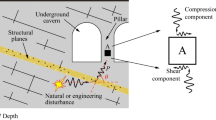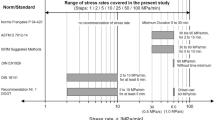Abstract
The strength of rock under combined compression and shear loading has been paid more and more attention, but still lacks a theoretical model that incorporates both compression–shear characteristics and influence of dip angle to estimate the strength of the rock. This work is aiming to solve the issue by combining experimental and theoretical methods. First, in the laboratory, 112 rock samples with different sizes were applied to obtain the dip effect characteristics of strength via combined compression–shear tests. The ratio of compression–shear strength to uniaxial compression strength is called the compression–shear coefficient, which is used to characterize the degree of dip effect. Second, according to the compression–shear load characteristics of inclined rock samples, a strength model was established considering both compression–shear characteristics and dip angle by the Mohr–Coulomb failure theory. This strength model is an extension of the Mohr–Coulomb criterion and was verified by experimental data. The verification results are consistent with experimental results. Finally, the mechanism of dip effect on strength was explained from the resistance to the sliding and stress path of the rock sample. The results show that the dip effect is an inevitable strength weakening characteristic of rock materials under combined compression–shear loading. Compared with the vertical rock sample loaded under pure pressure, the resistance to the sliding of inclined rock samples decreases and the stress path is changed, which reduces the ability of the rock sample to resist external loads, resulting in the decrease of strength.


















Similar content being viewed by others
Abbreviations
- F :
-
Total force applied the rock sample (N)
- Fn, Fs :
-
Axial force and tangential force of the rock sample (N)
- θ :
-
Dip of the rock sample (°)
- σθ, τθ :
-
Axial compressive stress and tangential shear stress of the rock sample (MPa)
- A :
-
Cross-section areas of the rock sample (m2)
- E, G :
-
Elastic modulus and shear modulus of the sample at a given dip angle (MPa)
- ε, γ :
-
Axial compressive strain and tangential shear strain of the sample at a given dip angle, 1
- d :
-
Displacement between two platens of the WAW-300 (m)
- w, h :
-
Width and height of the sample (m)
- ν :
-
Poisson’s ratio, 1
- σ p :
-
Total load of the rock sample (MPa)
- σθmax, τθmax :
-
Axial maximum compressive stresses and tangential maximum shear stresses at the moment of the rock sample failure (MPa)
- f(θ):
-
Compression–shear coefficient, 1
- a, b, c :
-
Regression coefficients (–)
- R 2 :
-
Correlation coefficient, 1
- σ c θ :
-
Inclined rock sample uniaxial compressive strength or compression–shear strength of rock sample (MPa)
- σ c0 :
-
Vertical rock sample uniaxial compressive strength (MPa)
- σ, τ :
-
Normal stress and shear stress action on any inclined plane in the rock sample (MPa)
- β :
-
Linear inclination angle of stress circle center (°)
- c :
-
Cohesion of rock sample (MPa)
- φ :
-
Internal friction angle of rock sample material (°)
- τ1, τ2 :
-
Resistance to the sliding (MPa)
- p1, p2 :
-
Equivalent confining pressure (MPa)
- μ :
-
Friction coefficient, 1
References
Ashab ASM, Ruan D, Lu G, Wong YC (2016) Quasi-static and dynamic experiments of aluminum honeycombs under combined compression-shear loading. Mat Des 97:183–194. https://doi.org/10.1016/j.matdes.2016.02.074
Bertuzzi R, Douglas K, Mostyn G (2016) An approach to model the strength of coal pillars. Int J Rock Mech Min Sci 89:165–175. https://doi.org/10.1016/j.ijrmms.2016.09.003
Bieniawski ZT (1968) The effect of specimen size on compressive strength of coal. Int J Rock Mech Min Sci Geomech Abstr 5(4):325–335. https://doi.org/10.1016/0148-9062(68)90004-1
Das AJ, Mandal PK, Paul PS, Sinha RK (2019a) Generalised analytical models for the strength of the inclined as well as the flat coal pillars using rock mass failure criterion. Rock Mech Rock Eng 52(10):3921–3946. https://doi.org/10.1007/s00603-019-01788-7
Das AJ, Mandal PK, Paul PS, Sinha RK, Tewari S (2019b) Assessment of the strength of inclined coal pillars through numerical modelling based on the ubiquitous joint model. Rock Mech Rock Eng 52(10):3691–3717. https://doi.org/10.1007/s00603-019-01826-4
Du H, Dai F, Xu Y, Yan Z, Wei M (2020) Mechanical responses and failure mechanism of hydrostatically pressurized rocks under combined compression-shear impacting. Int J Mech Sci 165:105219. https://doi.org/10.1016/j.ijmecsci.2019.105219
Feng XT (2016) Rock mechanics and engineering: surface and underground projects. CRC Press, Amsterdam
Gao W (2014) Study on the width of the non-elastic zone in inclined coal pillar for strip mining. Int J Rock Mech Min Sci 72:304–310. https://doi.org/10.1016/j.ijrmms.2014.09.013
Garza-Cruz T, Pierce M, Board M (2019) Effect of shear stresses on pillar stability: a back analysis of the Troy Mine experience to predict pillar performance at Montanore Mine. Rock Mech Rock Eng 52(12):4979–4996. https://doi.org/10.1007/s00603-019-02011-3
González-Nicieza C, Álvarez-Fernández MI, Menéndez-Díaz A, Álvarez-Vigil AE (2006) A comparative analysis of pillar design methods and its application to marble mines. Rock Mech Rock Eng 39(5):421–444. https://doi.org/10.1007/s00603-005-0078-z
He Q, Li Y, She S (2019) Mechanical properties of basalt specimens under combined compression and shear loading at low strain rates. Rock Mech Rock Eng 52(10):4101–4112. https://doi.org/10.1007/s00603-019-01806-8
He Q, Li Y, Xu J, Zhang C (2020a) Prediction of mechanical properties of igneous rocks under combined compression and shear loading through statistical analysis. Rock Mech Rock Eng 53(2):841–859. https://doi.org/10.1007/s00603-019-01948-9
He Q, Li Y, Zhou B, Wu B, Zhang X, Zhang S (2020b) Mechanical properties of granite under quasi-static compression combined shear loading. J Min Saf Eng 37(3):586–593. https://doi.org/10.13545/j.cnki.jmse.2020.03.018
Hou B, Ono A, Abdennadher S, Pattofatto S, Li YL, Zhao H (2011) Impact behavior of honeycombs under combined shear-compression. Part I: experiments. Int J Solids Struct 48(5):687–697. https://doi.org/10.1016/j.ijsolstr.2010.11.005
Hustrulid WA (1976) A review of coal pillar strength formulas. Rock Mech Rock Eng 8(2):115–145. https://doi.org/10.1007/BF01239762
Jaiswal A, Shrivastva BK (2009) Numerical simulation of coal pillar strength. Int J Rock Mech Min Sci 46(4):779–788. https://doi.org/10.1016/j.ijrmms.2008.11.003
Jessu K, Spearing A, Sharifzadeh M (2018) Laboratory and numerical investigation on strength performance of inclined pillars. Energies 11(11):3229. https://doi.org/10.3390/en11113229
Jessu KV, Spearing AJS (2018) Effect of dip on pillar strength. J S Afr I Min Metall 118(7):765–776. https://doi.org/10.17159/2411-9717/2018/v118n7a10
Jin T, Zhou Z, Wang Z, Wu G, Liu Z, Shu X (2015) Quasi-static failure behaviour of PMMA under combined shear–compression loading. Polym Test 42:181–184. https://doi.org/10.1016/j.polymertesting.2015.01.018
Li X, Kim E, Walton G (2019) A study of rock pillar behaviors in laboratory and in-situ scales using combined finite-discrete element method models. Int J Rock Mech Min Sci 118:21–32. https://doi.org/10.1016/j.ijrmms.2019.03.030
Ling C, Ivens J, Cardiff P, Gilchrist MD (2018) Deformation response of EPS foam under combined compression-shear loading. Part I: experimental design and quasi-static tests. Int J Mech Sci 144:480–489. https://doi.org/10.1016/j.ijmecsci.2018.06.014
Ma T, Wang L, Suorineni FT, Tang C (2016) Numerical analysis on failure modes and mechanisms of mine pillars under shear loading. Shock Vib 2016:1–14. https://doi.org/10.1155/2016/6195482
Mohan GM, Sheorey PR, Kushwaha A (2001) Numerical estimation of pillar strength in coal mines. Int J Rock Mech Min Sci 38(8):1185–1192. https://doi.org/10.1016/s1365-1609(01)00071-5
Pariseau W (2011) Design analysis in rock mechanics, 2nd edn. CRC Press, Balkema
Peng SS (2015) Topical areas of research needs in ground control—a state of the art review on coal mine ground control. Int J Min Sci Technol 25(1):1–6. https://doi.org/10.1016/j.ijmst.2014.12.006
Poulsen BA (2010) Coal pillar load calculation by pressure arch theory and near field extraction ratio. Int J Rock Mech Min Sci 47(7):1158–1165. https://doi.org/10.1016/j.ijrmms.2010.06.011
Poulsen BA, Adhikary DP (2013) A numerical study of the scale effect in coal strength. Int J Rock Mech Min Sci 63:62–71. https://doi.org/10.1016/j.ijrmms.2013.06.006
Sun X, Liu W, Chen W, Templeton D (2009) Modeling and characterization of dynamic failure of borosilicate glass under compression/shear loading. Int J Impact Eng 36(2):226–234. https://doi.org/10.1016/j.ijimpeng.2008.01.014
Suorineni FT, Mgumbwa JJ, Kaiser PK, Thibodeau D (2014) Mining of orebodies under shear loading part 2—failure modes and mechanisms. Min Technol 123(4):240–249. https://doi.org/10.1179/1743286314y.0000000072
Suorineni FT, Kaiser PK, Mgumbwa JJ, Thibodeau D (2013) Mining of orebodies under shear loading part 1—case histories. Min Technol 120(3):137–147. https://doi.org/10.1179/1743286311y.0000000012
Tounsi R, Markiewicz E, Zouari B, Chaari F, Haugou G (2017) Numerical investigation, experimental validation and macroscopic yield criterion of Al5056 honeycombs under mixed shear-compression loading. Int J Impact Eng 108:348–360. https://doi.org/10.1016/j.ijimpeng.2017.05.001
Tounsi R, Zouari B, Chaari F, Markiewicz E, Haugou G, Dammak F (2013) Reduced numerical model to investigate the dynamic behaviour of honeycombs under mixed shear-compression loading. Thin Wall Struct 73:290–301. https://doi.org/10.1016/j.tws.2013.08.016
Wang JA, Shang XC, Ma HT (2008) Investigation of catastrophic ground collapse in Xingtai gypsum mines in China. Int J Rock Mech Min Sci 45(8):1480–1499. https://doi.org/10.1016/j.ijrmms.2008.02.012
Xiang XM, Lu G, Li ZX, Lv Y (2017) Large deformation of tubes under oblique lateral crushing. Int J Impact Eng 110:138–148. https://doi.org/10.1016/j.ijimpeng.2017.01.020
Xu S, Huang J, Wang P, Zhang C, Zhou L, Hu S (2015) Investigation of rock material under combined compression and shear dynamic loading: an experimental technique. Int J Impact Eng 86:206–222. https://doi.org/10.1016/j.ijimpeng.2015.07.014
Xu Y, Dai F (2017) Dynamic response and failure mechanism of brittle rocks under combined compression-shear loading experiments. Rock Mech Rock Eng 51(3):747–764. https://doi.org/10.1007/s00603-017-1364-2
Zhang J, Jin T, Wang Z, Zhao L (2016) Experimental investigation on yield behavior of PMMA under combined shear–compression loading. Results Phys 6:265–269. https://doi.org/10.1016/j.rinp.2016.05.004
Zhou L, Xu S, Shan J, Liu Y, Wang P (2018) Heterogeneity in deformation of granite under dynamic combined compression/shear loading. Mech Mater 123:1–18. https://doi.org/10.1016/j.mechmat.2018.04.013
Zhou Z, Su B, Wang Z, Li Z, Shu X, Zhao L (2013) Shear-compression failure behavior of PMMA at different loading rates. Mater Lett 109:151–153. https://doi.org/10.1016/j.matlet.2013.05.081
Zuo J, Wang J, Jiang Y (2019) Macro/meso failure behavior of surrounding rock in deep roadway and its control technology. Int J Coal Sci Technol 6(3):301–319. https://doi.org/10.1007/s40789-019-0259-0
Acknowledgements
The authors wish to acknowledge the support from the Special Project of Central Government for Local Science and Technology Development of Hubei Province (2019ZYYD060) and the National Natural Science Foundation of China (no. 51574183, no. 51704213).
Author information
Authors and Affiliations
Corresponding author
Ethics declarations
Conflict of interest
The authors declare that they have no conflict of interest.
Additional information
Publisher's Note
Springer Nature remains neutral with regard to jurisdictional claims in published maps and institutional affiliations.
Rights and permissions
About this article
Cite this article
Luo, B., Ye, Y., Hu, N. et al. Investigation of Dip Effect on Uniaxial Compressive Strength of Inclined Rock Sample by Experimental and Theoretical Models. Rock Mech Rock Eng 53, 5659–5675 (2020). https://doi.org/10.1007/s00603-020-02234-9
Received:
Accepted:
Published:
Issue Date:
DOI: https://doi.org/10.1007/s00603-020-02234-9




